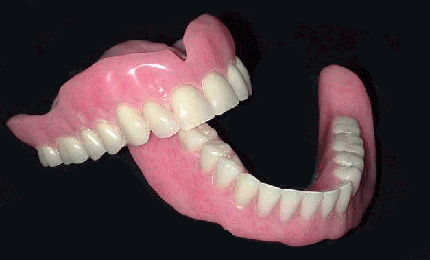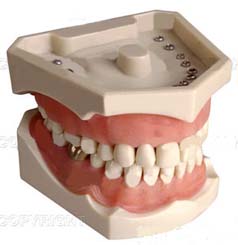If we are to talk about Dentures and prosthesis, first of all we have to explain what they are and when each of these is used.
Dentures are acrylic-based fake teeth.
There is an acrylic base that imitates the gums and fake acrylic or porcelain teeth that rest on top of the base.
This type of dentures and prosthesis is used when there are no teeth in a patient’s mouth.

Metal prosthesis is a prosthesis with a metal base and false teeth.
This type of dentures and prosthesis is used when there is at least one tooth (or more) remaining in a patient’s mouth.
You may ask since there are teeth remaining in the patient’s mouth why not make a bridge then. Well the answer to this is that you can’t always put a bridge to cover all the teeth missing. Sometimes there are not enough teeth to hold a bridge and sometimes even there are enough the patient does not want a bridge or cannot afford one.
So there you have it, we have figured out what these types of dentures and prosthesis are for, so now we can see what kind is suitable for our needs.
Dentures and prosthesis are usually well adapted on the maxilla (upper jaw). This is easy to understand if we find out how this denture actually holds on to the gums.
It is a rather big question…
There are no teeth to hold on so how does this denture and prosthesis stay put over there? Shouldn’t it just fall down?…
Well the answer is rather simple (elementary Watson – as the famous Sherlock Holmes would put it!) – Negative pressure.
The dentures and prosthesis – if it is designed properly – just sucks to the top like a leech.
Due to the negative pressure it holds on until you violently take it out or if you fill your mouth with air; thus you equalize the pressure in your mouth and under the prosthesis. It sounds perfect doesn’t it?
The problem is that not everyone has a mouth fit for a denture and prosthesis on the maxilla. Some mouths are rather flat, they do not provide the proper negative pressure for the denture to “glue” on to the top and they fall most of the time making the patients that wear them rather unhappy and frustrated.

Dentures and prosthesis for the lower jaw however are an entirely different story.
You see there can be no talk of negative pressure on the lower jaw. There is no space to create it since the tongue is located there and it is a rather powerful force that can move the denture without really much force.
Lower dentures and prosthesis do not “glue” on the gums like dentures and prosthesis for the upper jaw, but there are several techniques to make them more stable. The dentist can make the lower denture and prosthesis heavier and make its borders wider and longer in order to achieve better fixation. The results vary since every mouth is not the same.
So what do we do if we want our dentures and prosthesis to stay put?
There are a few solutions on this matter:
1) You can use a special type of glue for dentures and prosthesis.
That helps in many cases, there is also a number of special papers that are placed under the denture to ensure better fixation.
2) Sometimes the problem can be solved with some remodeling in the dentist’s office or with the construction of a new denture and prosthesis.
If you are not satisfied with any of these solutions and you can handle the financial cost, you can always proceed with a therapy based on implants in order to achieve the desired result – fixed dentures and prosthesis or even better fixed bridges.

You can find more information on this subject in our article on dental implants.
Partial dentures and prosthesis – or metal prosthesis if you prefer – can be of significant help if we have several teeth remaining.
As stated before if the patients does not want a bridge or there is no way to hold a bridge with the remaining teeth and the patient does not want any implants to replace the missing teeth, then this is a good solution.
The good thing about this kind of prosthesis is that it does not have a lot of hassle.
On the first day the dentist takes an impression of the lower and upper jaw, and on the next appointment the dentist tries on the metal base of the denture and prosthesis and takes note of the proper height.
In two more appointments you have a ready prosthesis and that is it.
Usually this kind of prosthesis does not give the patient any trouble since it is based on teeth and the gums of the missing teeth; it is quite stable and rather aesthetic.
One popular idea is to have your dentures and prosthesis done before, after or during your holidays in Greece or the Greek islands.
If you have any questions and would like to know more on this subject please contact one of our listed Greek dental specialists in dentures and prosthesis.
